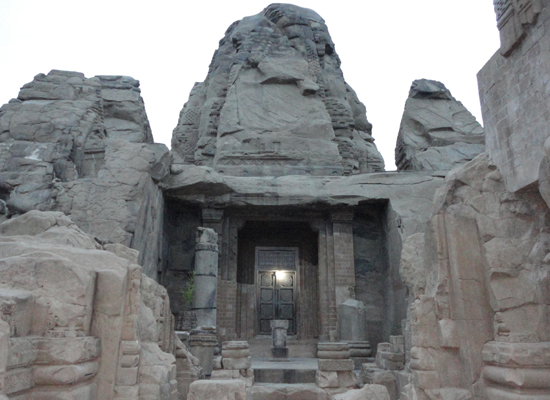Masroor Rock Cut Temple - Hindu temples in Kangra Valley

The Masroor Temple is a complex of rock cut Hindu temples at the Kangra Valley of Beas River. The temples were carved out of monolithic rock with a shikhara and provided with a sacred pool of water as recommended by Hindu texts on temple architecture. This Temple is a popular archaeological and pilgrimage site in Himachal Pradesh located about 40 KM away from Dharamsala. The Temple’s architecture follows North Indian Nagara style dedicated to Shiva, Vishnu, Devi and Saura traditions of Hinduism with its surviving iconography likely inspired by a henotheistic framework.
The Legends of Masroor Temples
According to a local legend, the Pandavas of Mahabharata fame resided here during their "incognito" exile from their kingdom and built this temple. But, the identity and location of Pandavas was exposed, so they shifted from here. This is said to be why the temple complex was left unfinished. Sometime in the 20th century someone introduced three small blackstone statues inside the shrine which faces east. These are of Rama, Lakshmana and Sita of the Ramayana fame.

Architecture of the Masroor Temple Complex
The main temple of the complex is called ‘Thakurdwara’ and was originally dedicated to Lord Shiva, but currently houses stone idols of Ram, Sita, and Laxmana. Thakurdwara is largest temple in the complex and is stationed right at the centre. Interiors and exteriors of the Thakurdwara are engraved with beautiful and intricate stone carvings. Thakurdwara is surrounded by seven small shrines, known as roof shrines. Beautiful stone carvings are sculpted on the exterior walls of these temples. A pair of spires (Shikhar) makes an entryway to the pillared hall (Mandapa). There are two cruciform shrines stationed inside the eastern court. The door frames of the temples feature beautiful carvings of Indian Gods and Goddesses namely Surya, Indra, Durga, Ganesha, and Kartikeya. The ceiling of the sanctum and antechamber boast elegant lotus decorations that are encircled by diamond-shaped patterns. Each lintel features five deities seating on lotus, and the row above all the deities is decorated with peacock carvings. Just like the legend claims, there is an incomplete stone staircase within the temple complex, which can be accessed by the visitors. The staircase leads to adjacent rocks of the same sandstone ridge, providing bird’s eye view of the entire complex. Right in front of this temple complex lays a beautiful pond known as the Masoor Lake. This lake is a remarkable piece of engineering as well. The detailed mirror image of each monolith temple is reflected on its clear water.

Sculpture of the Masroor Temple Complex
The main sanctum has nine seated deities. The center one is Shiva, and with him are others including Vishnu, Indra, Ganesa, Kartikiya and Durga. The shrines around the central shrine feature five Devis in one case, while other shrines reverentially enshrine Vishnu, Lakshmi, Ganesha, Kartikeya, Surya, Indra and Saraswati. The avatars of Vishnu such as the Varaha and the Narasimha are presented in the niches. In the ruins have been found large sculptures of Varuna, Agni and others Vedic deities. The temple also includes fusion or syncretic ideas revered in Hinduism, such as Ardhanarishvara (half Parvati, half Shiva), Harihara (half Vishnu, half Shiva) and a three faced trinity that shows Brahma, Vishnu and Shiva in one sculpture. The temple also has secular images from the common life of people, of couples in courtship and various levels of intimacy (mithuna), people making music and dancing, apsaras and ornamental scrollwork.
Information for Visitors
- Best time to visit: May to October
- Masroor Rock Cut Temple is Open for visitors: Daily from 6:00 AM - 6:00 PM
- Grand Festivals: Ram Navami and Janamashtmi are celebrated wholeheartedly at this temple complex.
- Famous For: Religion, History, Architecture and Photography
How to Reach Masroor Rock Cut Temple
The Masroor Rock Cut Temple is located at a distance of 43 km from Dharamshala. You can hire a car or a shared taxi to reach this ancient temple. Nearest Railway station is Pathankot (85 KM away).
Visiting Hours
Masroor Rock Cut Temple is open for visitors from 09:00 to 18:00.Best Time To Visit
The best time to visit Masroor Rock Cut Temple is in months of May, June, July, August, September, October.-
Hotel near Masroor Rock Cut Temple
- Hotel near Masroor Rock Cut Temple is Fortune Select Forest Hill Resort (232 Km, 6hr 23min).
 EN
EN